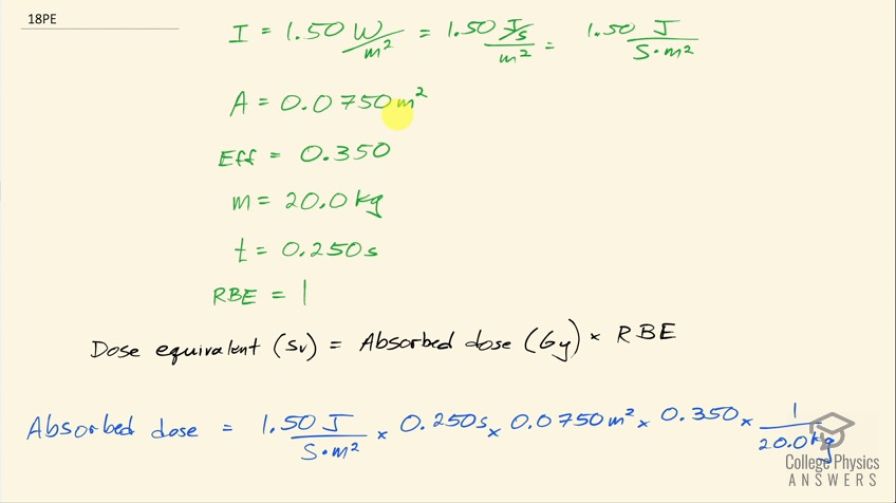Question
Calculate the dose in Sv to the chest of a patient given an x-ray under the following conditions. The x-ray beam intensity is , the area of the chest exposed is , 35.0% of the x-rays are absorbed in 20.0 kg of tissue, and the exposure time is 0.250 s.
Final Answer
Solution video
OpenStax College Physics for AP® Courses, Chapter 32, Problem 18 (Problems & Exercises)

vote with a rating of
votes with an average rating of
.
Calculator Screenshots
Video Transcript
This is College Physics Answers with Shaun Dychko. A patient is given a chest x-ray and the area of their chest is 0.0750 square meters the x-ray beam has an intensity of 1.50 watts per square meter and the efficiency of absorption is 0.350 because 35.0 percent of the radiation is absorbed the mass of the chest is 20.0 kilograms and the duration of the x-ray beam is 0.250 seconds and we also look up the relative biological effectiveness of x-rays and it is 1— I am going to convert the units of this intensity into joules per second per square meter just because that's helpful for the work we are going to do to calculate the absorbed dose. What we want to know is the dose equivalent in sieverts, which is the absorbed dose in grays which is really shorthand for units of joules per kilogram multiplied by relative biological effectiveness and let's figure out what this absorbed dose is. So I am writing the intensity as 1.50 joules per second per square meter and the way I solve a question like this is often just by looking at the units so we want to have joules per kilogram in our answer because that's what grays are— joules per kilogram— so let's multiply and divide as needed in order to create those units. So we are going to multiply by 0.250 seconds so the seconds cancel and this gives us the number of joules then multiply by 0.0750 square meters which tells us... well, sorry before we had joules per square meter and now we have just joules. Then we multiply by 0.350 because that's the efficiency— that's the fraction absorbed by the tissue— and then divide by 20.0 kilograms to get the joules per kilogram so that's 4.92188 times 10 to the minus 4 grays, which is the shorthand for joules per kilogram. And then to get the answer in sieverts, we multiply the dose absorbed in grays by the RBE, which is 1 for x-rays and that is 4.92 times 10 to the minus 4 sieverts.
